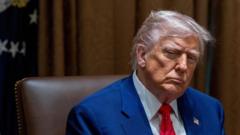After an intense week of trade negotiations and policy adjustments, President Donald Trump has put parts of his sweeping tariff strategy on hold, stalling higher tariffs on most nations for 90 days while continuing his confrontation with China. With this partial retreat comes the question of whether Trump is any closer to achieving his ambitious trade goals. Here’s a closer look at five major objectives he has outlined and their current status.
1) **Negotiating Better Trade Deals**
What Trump envisioned: Trump's rhetoric has centered on the notion that the U.S. has been exploited by both allies and adversaries in trade agreements. His initial tariff proposal, which included a blanket 10% duty on all imports, sent shockwaves internationally, compelling countries to negotiate for trade concessions quickly. The administration claims that over 75 world leaders have already reached out for negotiations, such as the discussions underway with South Korea and Japan.
Current Status: The countdown is on for a resolution as allies scramble to finalize agreements before the 90-day window closes, indicating a potential breakthrough in negotiations.
2) **Revitalizing American Manufacturing**
What Trump argued: Trump has long maintained that tariffs can restore American manufacturing capabilities by fending off foreign competition. Although some factories may expand their output quickly, broader investment in domestic manufacturing will require stable long-term policies. Recent volatility, including fluctuating tariffs, creates uncertainty for businesses about their future manufacturing strategies.
Current Status: The unpredictable tariff landscape raises concerns among manufacturers, who may opt to delay significant investments until a clearer picture emerges regarding tariff consistency.
3) **Engaging China in Trade Tensions**
What Trump stated: While expressing respect for China, Trump has repeatedly labeled the nation as a major source of U.S. trade issues. His administration has indicated that targeting China is a priority, yet the high stakes of such a confrontation could have wider repercussions.
Current Status: Although seeking to confront China, the ramifications of this trade war could risk alienating international allies, which may be crucial for any long-term resolution.
4) **Boosting National Revenue through Tariffs**
What Trump projected: Trump has continually highlighted the potential for tariffs to generate government revenue that could be used for tax reductions and debt alleviation. Studies suggest a 10% universal tariff could yield $2 trillion in revenue over a decade.
Current Status: If Trump continues with his proposed tariffs, the anticipated revenue influx may materialize, presenting a risk of diminishing returns if Americans shift towards domestic goods.
5) **Lowering Costs for American Consumers**
What Trump envisioned: By boosting domestic production, Trump posited that consumer prices would decrease, heralding a prosperous era for America. However, economic analysis warns that tariffs typically lead to higher prices for consumers, which contradicts his intentions.
Current Status: Subsequent to Trump's tariff announcements, the initial forecast suggests rising costs for American households, thereby posing a significant challenge to his public image and the future electoral success of his party.
As President Trump maneuvers through these complex trade dynamics, the real test remains whether he can successfully balance his ambitious goals with the economic realities that accompany such sweeping policy changes.
1) **Negotiating Better Trade Deals**
What Trump envisioned: Trump's rhetoric has centered on the notion that the U.S. has been exploited by both allies and adversaries in trade agreements. His initial tariff proposal, which included a blanket 10% duty on all imports, sent shockwaves internationally, compelling countries to negotiate for trade concessions quickly. The administration claims that over 75 world leaders have already reached out for negotiations, such as the discussions underway with South Korea and Japan.
Current Status: The countdown is on for a resolution as allies scramble to finalize agreements before the 90-day window closes, indicating a potential breakthrough in negotiations.
2) **Revitalizing American Manufacturing**
What Trump argued: Trump has long maintained that tariffs can restore American manufacturing capabilities by fending off foreign competition. Although some factories may expand their output quickly, broader investment in domestic manufacturing will require stable long-term policies. Recent volatility, including fluctuating tariffs, creates uncertainty for businesses about their future manufacturing strategies.
Current Status: The unpredictable tariff landscape raises concerns among manufacturers, who may opt to delay significant investments until a clearer picture emerges regarding tariff consistency.
3) **Engaging China in Trade Tensions**
What Trump stated: While expressing respect for China, Trump has repeatedly labeled the nation as a major source of U.S. trade issues. His administration has indicated that targeting China is a priority, yet the high stakes of such a confrontation could have wider repercussions.
Current Status: Although seeking to confront China, the ramifications of this trade war could risk alienating international allies, which may be crucial for any long-term resolution.
4) **Boosting National Revenue through Tariffs**
What Trump projected: Trump has continually highlighted the potential for tariffs to generate government revenue that could be used for tax reductions and debt alleviation. Studies suggest a 10% universal tariff could yield $2 trillion in revenue over a decade.
Current Status: If Trump continues with his proposed tariffs, the anticipated revenue influx may materialize, presenting a risk of diminishing returns if Americans shift towards domestic goods.
5) **Lowering Costs for American Consumers**
What Trump envisioned: By boosting domestic production, Trump posited that consumer prices would decrease, heralding a prosperous era for America. However, economic analysis warns that tariffs typically lead to higher prices for consumers, which contradicts his intentions.
Current Status: Subsequent to Trump's tariff announcements, the initial forecast suggests rising costs for American households, thereby posing a significant challenge to his public image and the future electoral success of his party.
As President Trump maneuvers through these complex trade dynamics, the real test remains whether he can successfully balance his ambitious goals with the economic realities that accompany such sweeping policy changes.



















